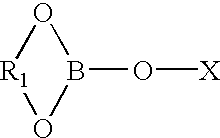Topical application for treating toenail fungus
a technology for treating toenail fungus and fingernails, applied in the field of human fingernails and toenails, can solve the problems of nail plate separation, nail thickening and lusterless, and debris accumulation under the free edge, and achieves the effect of curing onychomycosis without skin irritation and powerful potency
- Summary
- Abstract
- Description
- Claims
- Application Information
AI Technical Summary
Benefits of technology
Problems solved by technology
Method used
Image
Examples
examples 1-15
2,2′-(1-methyltrimethylenedioxy)bis-(4-methyl-1,3,2-dioxaborinane) (hereinafter compound S1) and 2,2′-oxybis(4,4,6-trimethyl-1,3,2-dioxaborinane) (hereinafter compound S2) are each prepared and purified according to the procedures described in U.S. Pat. No. 2,741,548. One or both of the dioxaborinanes is mixed with a sterile U.S.P. grade of white mineral oil in varying proportions as shown in Table I below to form compositions of the invention. The mineral oil is produced by E. R. Squibb & Sons Inc., Princeton, N.J. A control composition consists of the mineral oil alone.
The compositions are evaluated according to an approved surface carrier disinfection test (Official Methods of Analysis of the Association of Official Analytical Chemists protocol 991.47: Hard surface carrier test method). Cultures of Candida albicans are grown for 24 hours at room temperature in trypsin soy broth to a density of approximately McFarland standard #10. Sterile glass cylinders (Belco Cat. #2090-S0012) ...
example 16
A male volunteer 43 years old has onychomycosis of the toenails on both feet. To the toenails of the left foot is applied a mixture consisting of 25 wt % of compounds S1 and S2 in 50 / 50 w / w proportion, and 75 wt. % of low viscosity petroleum jelly. Selection of this composition is based on the examples of 1-15, which indicates that a 25% loading of either S1 or S2 or combinations thereof completely destroys the fungus. The clinical tests are done to evaluate effectiveness and skin reactions, if any. This mixture is reapplied nightly. To the toenails of the right foot is applied a mixture of 25 wt % of compounds S1 and S2 in 50 / 50 w / w proportion, 70 wt % acetone and 5 wt % cellulose acetate. This mixture is applied once per week after the previous week's application is removed with acetone. At the end of 6 weeks of treatment, the toenails of each foot have a clear, uninfected zone of 2 mm in width. At the end of 12 weeks of treatment, the clear zone is 4 mm in width. At the end of 20...
example 17
A male volunteer 58 years old has onychomycosis on both feet. At least four toes in each foot are infected. He applies the solution, which has 25% of active ingredients in mineral oil with a 50 / 50 S1 / S2 ratio, to both feet once a day. The application included painting the entire toenail and the cuticle for approximately 3 mm beyond the nail. After 90 days 3 mm of clear infection free nail could be seen. After 125 days, more than three-quarter of the nail is clear, free from infection. The boundary between the infected portion and the clear portion is not smooth and shows structure. In 250 days, the nail is fully-grown, completely free from any infection. No skin irritation is observed.
PUM
 Login to View More
Login to View More Abstract
Description
Claims
Application Information
 Login to View More
Login to View More - R&D
- Intellectual Property
- Life Sciences
- Materials
- Tech Scout
- Unparalleled Data Quality
- Higher Quality Content
- 60% Fewer Hallucinations
Browse by: Latest US Patents, China's latest patents, Technical Efficacy Thesaurus, Application Domain, Technology Topic, Popular Technical Reports.
© 2025 PatSnap. All rights reserved.Legal|Privacy policy|Modern Slavery Act Transparency Statement|Sitemap|About US| Contact US: help@patsnap.com


